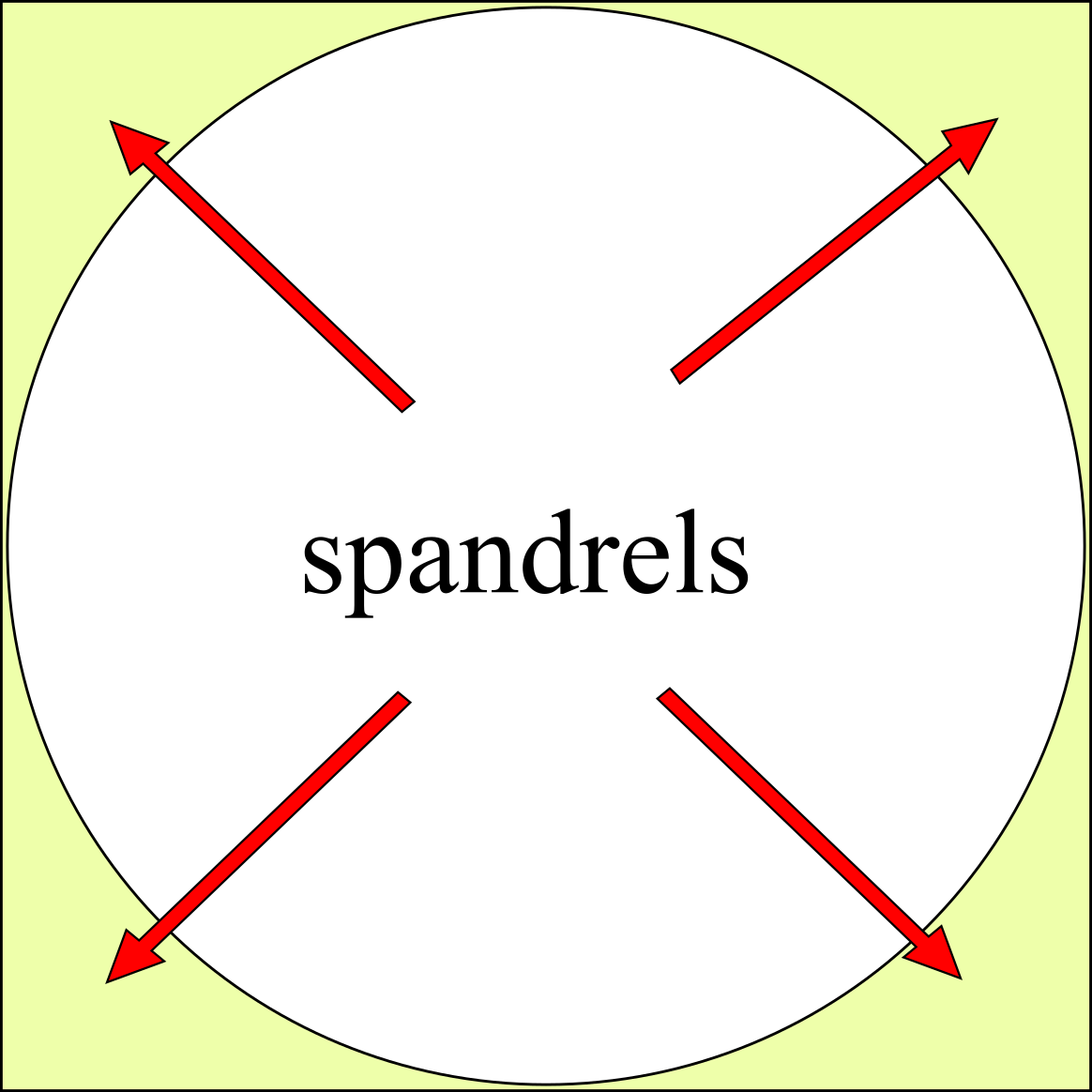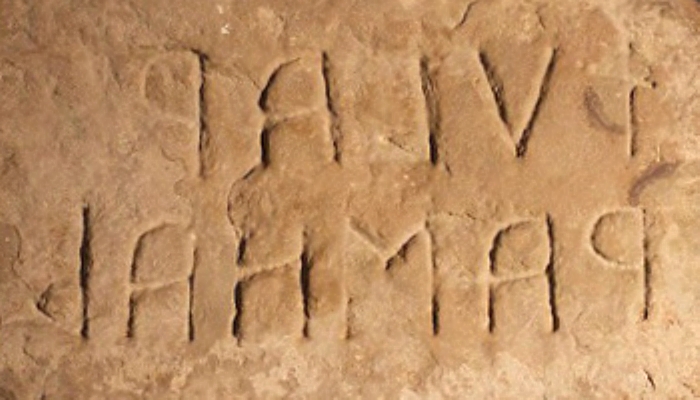|
Alfiz
The alfiz (, from Andalusi Arabic ''alḥíz'', from Standard Arabic ''alḥáyyiz'', meaning 'the container'; "''DRAE. Diccionario de la Lengua Española. Vigésima segunda edición''", Espasa Calpe, S.A, 2003) is an architectural adornment, consisting of a moulding, usually a rectangular panel, which encloses the outward side of an arch. It is an architectonic ornament of Etruscan origin, used in , Asturian, |
Spandrel
A spandrel is a roughly triangular space, usually found in pairs, between the top of an arch and a rectangular frame, between the tops of two adjacent arches, or one of the four spaces between a circle within a square. They are frequently filled with decorative elements. Meaning There are four or five accepted and cognate meanings of the term ''spandrel'' in architecture, architectural and art history, mostly relating to the space between a curved figure and a rectangular boundary – such as the space between the curve of an arch and a rectilinear bounding moulding, or the wallspace bounded by adjacent arches in an arcade and the stringcourse or moulding above them, or the space between the central medallion of a carpet and its rectangular corners, or the space between the circular face of a clock and the corners of the square revealed by its hood. Also included is the space under a flight of stairs, if it is not occupied by another flight of stairs. In a building with more ... [...More Info...] [...Related Items...] OR: [Wikipedia] [Google] [Baidu] |
Andalusian Arabic
Andalusi Arabic or Andalusian Arabic () was a variety or varieties of Arabic spoken mainly from the 8th to the 15th century in Al-Andalus, the regions of the Iberian Peninsula under the Muslim rule. Arabic spread gradually over the centuries of Muslim rule in Iberia, primarily through conversion to Islam, although it was also learned and spoken by Christians and Jews. Arabic became the language of administration and was the primary language of literature produced in al-Andalus; the Andalusi vernacular was distinct among medieval Arabic vernaculars in that it was used in poetry, in '' zajal'' and the '' kharjas'' of '' muwaššaḥāt''. Arabic in al-Andalus existed largely in a situation of bilingualism with Andalusi Romance (known popularly as ''Mozarabic'') until the 13th century. Arabic in Iberia was also characterized by diglossia: in addition to standard written Arabic, spoken varieties could be subdivided into an urban, educated idiolect and a register of the less-p ... [...More Info...] [...Related Items...] OR: [Wikipedia] [Google] [Baidu] |
Arabic
Arabic (, , or , ) is a Central Semitic languages, Central Semitic language of the Afroasiatic languages, Afroasiatic language family spoken primarily in the Arab world. The International Organization for Standardization (ISO) assigns language codes to 32 varieties of Arabic, including its standard form of Literary Arabic, known as Modern Standard Arabic, which is derived from Classical Arabic. This distinction exists primarily among Western linguists; Arabic speakers themselves generally do not distinguish between Modern Standard Arabic and Classical Arabic, but rather refer to both as ( "the eloquent Arabic") or simply ' (). Arabic is the List of languages by the number of countries in which they are recognized as an official language, third most widespread official language after English and French, one of six official languages of the United Nations, and the Sacred language, liturgical language of Islam. Arabic is widely taught in schools and universities around the wo ... [...More Info...] [...Related Items...] OR: [Wikipedia] [Google] [Baidu] |
Etruscan Civilization
The Etruscan civilization ( ) was an ancient civilization created by the Etruscans, a people who inhabited Etruria in List of ancient peoples of Italy, ancient Italy, with a common language and culture, and formed a federation of city-states. After adjacent lands had been conquered its territory covered, at its greatest extent, roughly what is now Tuscany, western Umbria and northern Lazio, as well as what are now the Po Valley, Emilia-Romagna, south-eastern Lombardy, southern Veneto and western Campania. A large body of literature has flourished on the origins of the Etruscans, but the consensus among modern scholars is that the Etruscans were an indigenous population. The earliest evidence of a culture that is identifiably Etruscan dates from about 900 BC. This is the period of the Iron Age Villanovan culture, considered to be the earliest phase of Etruscan civilization, which itself developed from the previous late Bronze Age Proto-Villanovan culture in the same region, p ... [...More Info...] [...Related Items...] OR: [Wikipedia] [Google] [Baidu] |
Visigothic Art And Architecture
The Visigoths entered Hispania (modern Spain and Portugal) in 415 and they rose to be the dominant people there until the Umayyad conquest of Hispania of 711 brought their kingdom to an end. This period in Iberian art is dominated by their style. Visigothic art is generally considered in the English-speaking world to be a strain of Migration art, while the Portuguese- and Spanish-speaking worlds generally classify it as Pre-Romanesque. Branches of Visigothic art include their architecture, crafts (especially jewellery), and their script. Visigothic architecture Visigothic architecture reflects the roots of late antiquity and early Christian architecture. The Visigoths gradually occupied Gaul and the Iberian Peninsula from the 5th to the 6th century. During the 6th century, they created a stable state entity, which reached its peak in the second half of the 7th century. The brief Byzantine occupation between 554 and 626 of the southeastern region (Provincia ''Spaniae'') ... [...More Info...] [...Related Items...] OR: [Wikipedia] [Google] [Baidu] |
Asturian Architecture
Pre-Romanesque architecture in Asturias is framed between the years 711 and 910, the period of the creation and expansion of the kingdom of Asturias. History In the 5th century, the Goths, a Christianized tribe of Eastern Germanic origin, arrived in the Iberian Peninsula after the fall of the Roman Empire, and dominated most of the territory, attempting to continue Roman order by the so-called ''Ordo Gothorum''. In the year 710, the Visigothic king Wittiza died, and instead of being succeeded by the eldest of his three sons, Agila II, Agila, the throne was usurped by the duke of Baetica, Roderic. The young heir sought support to recover the throne, and apart from local backing, he approached the Muslim Kingdom in northern Africa. Tarik, the caliph of Damascus governor in Tangier, received permission to offer his army and disembark in Spain, ready to face the Visigothic army of King Roderic. On July 19, 711, the battle of Guadalete took place near Gibraltar, where supporters of W ... [...More Info...] [...Related Items...] OR: [Wikipedia] [Google] [Baidu] |
Moorish Architecture
Moorish architecture is a style within Islamic architecture that developed in the western Islamic world, including al-Andalus (the Iberian Peninsula) and what is now Morocco, Algeria, and Tunisia (part of the Maghreb). Scholarly references on Islamic architecture often refer to this architectural tradition in terms such as architecture of the Islamic West or architecture of the Western Islamic lands. This architectural tradition integrated influences from pre-Islamic Roman, Byzantine, and Visigothic architectures, from ongoing artistic currents in the Islamic Middle East, and from North African Berber traditions. Major centers of artistic development included the main capitals of the empires and Muslim states in the region's history, such as Córdoba, Kairouan, Fes, Marrakesh, Seville, Granada and Tlemcen. While Kairouan and Córdoba were some of the most important centers during the 8th to 10th centuries, a wider regional style was later synthesized and shared across the Ma ... [...More Info...] [...Related Items...] OR: [Wikipedia] [Google] [Baidu] |
Mozarabic Art And Architecture
Mozarabic art is an early Middle Ages, medieval artistic style that is part of the Pre-Romanesque art and architecture, pre-Romanesque style and emerged in al-Andalus and in the kingdom of León. It's named after the Mozarabs (from ''musta'rab'' meaning "Arabized"), the Christians of al-Andalus. It was developed by the Hispanic Christians who lived in Arab-Muslim territory and in the expansion territories of the León crown, in the period from the Arab-Islamic Conquest of the Iberian Peninsula (711) to the end of the 11th century. During this period, disciplines such as painting, goldsmithing and architecture with marked Caliphate influences were cultivated in a context of medieval coexistence - Christian, Hebrew and Muslim - in which the territories were constantly changing in size and status. Other names for this artistic style are ''Leonese art'' or Repoblación art and architecture, repopulation art. Description Mozarabic art is a diverse and hybrid artistic expression that fl ... [...More Info...] [...Related Items...] OR: [Wikipedia] [Google] [Baidu] |
Mudéjar Art
Mudéjar art, or Mudéjar style, was a type of ornamentation and decoration used in the Iberian Peninsula, Iberian Christian kingdoms, primarily between the 13th and 16th centuries. It was applied to Romanesque architecture, Romanesque, Gothic art, Gothic and Renaissance architectural styles as constructive, ornamental and decorative motifs derived from those that had been brought to or developed in Al-Andalus. These motifs and techniques were also present in the art and crafts, especially Hispano-Moresque ware, Hispano-Moresque lustreware that was once widely exported across Europe from southern and eastern Spain at the time. The term ''Mudejar art'' was coined by the art historian José Amador de los Ríos, José Amador de los Ríos y Serrano in reference to the Mudéjars, who played a leading role in introducing Islamic derived decorative elements into the Iberian Christian kingdoms. The Mudéjars were the Muslims who remained in the former areas of Al-Andalus after the Christ ... [...More Info...] [...Related Items...] OR: [Wikipedia] [Google] [Baidu] |
Isabelline (architectural Style)
The Isabelline style, also called the Isabelline Gothic (), or Castilian late Gothic, was the dominant architectural style of the Crown of Castile during the reign of the Catholic Monarchs, Queen Isabella I of Castile and King Ferdinand II of Aragon in the late-15th century to early-16th century. The Frenchman Émile Bertaux named the style after Queen Isabella. It represents the transition between late Gothic and early Renaissance architecture, with original features and decorative influences of the Castilian tradition, the Flemish, the Mudéjar, and to a much lesser extent, Italian architecture. The consideration or not of the Isabelline as a Gothic or Renaissance style, or as an Eclectic style, or as a phase within a greater Plateresque generic, is a question debated by historians of art and unresolved. Overview The Isabelline style introduced several structural elements of the Castilian tradition and the typical flamboyant forms of Flanders, as well as some ornaments of M ... [...More Info...] [...Related Items...] OR: [Wikipedia] [Google] [Baidu] |
Horseshoe Arch
The horseshoe arch (; ), also called the Moorish arch and the keyhole arch, is a type of arch in which the circular curve is continued below the horizontal line of its diameter, so that the opening at the bottom of the arch is narrower than the arch's full span. Evidence for the earliest uses of this form are found in Late antique, Late Antique and Sasanian architecture, and it was then used in Spain by the Visigoths. But in the 19th century, perhaps when these earlier uses had not been realized, it became emblematic of Islamic architecture, especially Moorish architecture and Mozarabic art in Iberia. It also made later appearances in Moorish Revival architecture, Moorish Revival and Art Nouveau styles. Horseshoe arches can take rounded, pointed or Multifoil arch, lobed form. History Origins and early uses The origins of the horseshoe arch are complicated. It appeared in pre-Islamic Sasanian architecture such as the Taq Kasra, Taq-i Kasra in present-day Iraq and the Palace ... [...More Info...] [...Related Items...] OR: [Wikipedia] [Google] [Baidu] |








